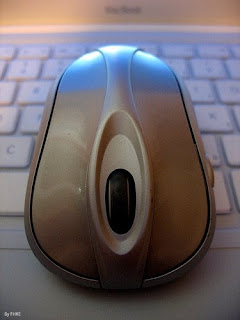The Right Mouse Button
By: Scott Hendison 
Until Windows 95 came along, the right mouse button was rarely used. In November of 1999 I wrote an article called “Mousing Around”. It explains the basic functions of mouse use, but deals only with using the left mouse button.
The right mouse button offers a variety of options that can save you lots of time when used at the right time. For instance…
To change your screen saver or display options, you can go to the Start button – settings – control panel, and then double click on the display option. A faster way to get there though is to just put the mouse cursor in any blank area of your Windows desktop. Right click once and select “properties”. Same place, less time.
To create a new Microsoft notepad document to type a grocery list or quick memo etc. you can go to the Start button – Programs – Accessories – Notepad. A faster way to get there is to right click again on a blank area of your desktop and select New. From there, you can choose Notepad (or whatever listed program you want). Same place, less time. Windows has an annoying habit of placing your newly installed software at the bottom of your Start – Programs menu. For someone with a lot of software installed, it can take a while tot find the program you want. If you go to the Start – Programs menu, you can right click anywhere on the menu, and select “sort by name”. This will instantly alphabetize your entire Programs menu, allowing you to instantly find whatever you’re looking for.
The right mouse button can also be used to copy and paste information from one document to another. For an example of this, go to any website, or open any e-mail or word processing document. Now select some text to copy. To do this, just place your mouse cursor at the point where you want to start copying. Next, “click and drag” (Left click, holding button down, move the mouse) to the end of the text you want to copy (then let go of button). Notice how the text becomes colorized or “highlighted”? Now RIGHT click anywhere on that highlighted area, and select “copy”. That information that you have “copied” is now on your “clipboard” for use somewhere else. If you create a new e-mail or open a word processor, or even Microsoft Notepad, you can just right click anywhere in the body of the document, and select “paste”. Voila!
The copy and paste function can also be used for entire files as well as for text. For example, open “My Documents”. Pick any document of any kind, right click on it, and select “copy”. Now a copy of that file is on your clipboard and you can “paste” it wherever you want. On your desktop? Easy. Into the body of and e-mail? No problem.
Notice that there is another option on that right click menu besides “copy”, called “cut”. Many times instead of making a copy of the file or text, you will prefer to cut or remove it from its original location instead. This works the same way, placing it on your clipboard for use elsewhere. This is handy for moving files around, or rearranging entire paragraphs in documents like this one.
Just remember that you can only “cut” text or pictures if you are in a local document that you are otherwise able to edit anyway. In other words, you won’t be able to go to CNN’s website and “cut” a news story, to paste into a document. You’ll have to settle for copying.
This is by no means the end of the list of functions that your right mouse button can help you with, but it’s the end of my column for this month. Don’t be afraid to experiment a little. Even I have been amazed at the variety of right click options I’ve discovered over the last few days while writing this article.
Scott Hendison is an computer & internet consultant living in Portland Oregon and works with companies all over the world. His website is http://www.pdxtc.com
Copyright 2001, All Rights Reserve







0 comments:
Post a Comment